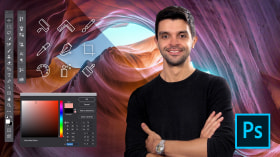Tips for Developing Your Photographic Aesthetic: Composition, Lighting, and Colors by Gustavo Zylbersztajn
The art of photography transcends the mere capture of images, involving the expression of a unique and personal vision. Here are some tips focused on the main aspects of composition, lighting, and colors to help you develop your photographic aesthetic and create an authorial portfolio that speaks directly to your essence.
Explore Dynamic Composition
- Vary Perspectives: Experiment with different angles and viewpoints to add dynamism to your photos.
- Play with Negative Space: Use empty space to highlight your subject and create a more breathable composition.
- Incorporate Textures and Patterns: Textures and patterns can add depth and visual interest to your images.
- Visual Balance: Seek a balance among the elements of your photo to guide the viewer's gaze through the image.
Master Lighting
- Natural vs. Artificial Light: Decide between using natural light, which offers softness and realism, or artificial light for more control and drama.
- Experiment with Shadows: Use shadows to add mystery, depth, and shape to your photos.
- Light Direction: The direction of light can completely change the atmosphere of a photo. Experiment with different directions to see how they affect the subject.
- Light Modifiers: Reflectors, diffusers, and scrims can help to soften or direct light, creating various effects.
Use Colors to Tell Stories
- Color Palette: Choose a color palette that complements the theme of your story or the emotion you want to convey.
- Saturation and Contrast: Adjustments in saturation and contrast can intensify or soften the atmosphere of your images.
- Color Harmony: Use complementary or analogous colors to create visual harmony or dissonance, depending on the desired effect.
- Color Symbolism: Consider the meaning and symbolism of colors to add layers of interpretation to your visual narrative.
Support the Narrative with Details
- Focus on Details: Details can be powerful in adding interest and depth to your story, capturing the essence of a moment.
- Close-ups: Use close-ups to highlight important elements and show unique perspectives.
- Supporting Elements: Every detail should serve the narrative, reinforcing the theme or emotion of your story.
Developing your own photographic aesthetic is an ongoing process of experimentation and expression. Each photo is an opportunity to tell a story, convey an emotion, or capture a moment through your unique lens. Remember, photography is a personal and creative journey, where you are the visual narrator.
For more tips and techniques on enhancing your photographic language, I invite you to check out my new course on Domestika, where we dive deep into the art of creating images that not only capture but also speak.







0 comments